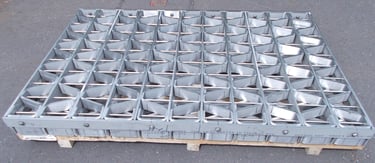Share this
What is Tempering?
by Therser Sales Team on 09-May-2023 09:33:54
Tempering is a heat treatment process applied to metals, typically steel, to improve its mechanical properties. It involves heating the metal to a specific temperature and then cooling it in a controlled manner. The purpose of tempering is to reduce the brittleness of the material while increasing its toughness and ductility.
The tempering process follows a previous heat treatment step called quenching, where the metal is rapidly cooled from a high temperature to room temperature to achieve a hardened state. However, the resulting hardened metal is often too brittle and prone to cracking or breaking under certain conditions.
Tempering aims to alleviate the brittleness introduced by quenching by selectively reheating the hardened metal to a lower temperature and allowing it to cool at a controlled rate. This controlled heating and cooling cycle enables the formation of a more desirable balance between hardness and toughness.

The specific temperature used during tempering depends on the desired properties of the material. Different temperature ranges and durations can be employed to achieve specific hardness, toughness, and strength characteristics. The process is typically carried out in a furnace or with the use of localized heating methods, such as flames or induction heating.
During tempering, several changes occur within the metal:
-
Reduction of hardness: The reheating of the hardened metal causes the formation of small, uniform carbide particles. These carbides reduce the internal stresses and hardness of the material, making it less brittle.
-
Improvement of toughness and ductility: The tempering process increases the material's toughness and ductility by allowing the redistribution of carbon atoms. This redistribution helps relieve stress concentrations and enables the metal to absorb energy and deform without fracturing.
-
Retained strength: While tempering reduces the hardness, it also helps maintain a significant portion of the material's strength obtained through quenching. This combination of strength and improved toughness is often desirable for many applications.
The tempering process is widely used in various industries where the mechanical properties of steel need to be optimized. It is employed in the manufacturing of tools, machine components, structural parts, and other steel-based products. The specific tempering parameters are determined based on the desired balance of hardness, toughness, and strength required for the intended application.
Please contact our sales team today on 44 (0)1782 824453 or drop us an email to sales@therseruk.com
Share this
- Company News (90)
- Battery Materials (41)
- kiln (37)
- fabrication (29)
- Alloy (27)
- Furnace (27)
- Welding (16)
- Industrial Kilns (15)
- Battery (13)
- Ceramic Kilns (13)
- Processes (13)
- alloy fabrication (13)
- Shuttle Kilns (12)
- RTO’s (11)
- Vacancies (11)
- Hydrogen (10)
- Therser UK (9)
- Tunnel Kiln (9)
- Refractory (8)
- Therser (8)
- Wellman Furnaces (8)
- Brickwork (7)
- Case Studies (7)
- Afterburners (6)
- Fibre Lining (6)
- electric (6)
- Almor Wellman (5)
- thermal engineers (5)
- Biochar (4)
- Exhibition (4)
- Pyrolysis (4)
- Servicing (4)
- Spares (4)
- heat treatment (4)
- History (3)
- Ceramics Uk (2)
- Combustion Control Upgrades (2)
- Nitrogen (2)
- Temperature Control Rings (2)
- gas (2)
- Certificates (1)
- Instrumentation (1)
- MMC (1)
- RHK (1)
- Roller Hearth Kiln (1)
- Test Trials (1)
- aerospace (1)
- analyser (1)
- elec (1)
- oxygen (1)
- vans (1)
- September 2025 (2)
- May 2025 (2)
- March 2025 (1)
- February 2025 (2)
- January 2025 (5)
- December 2024 (5)
- November 2024 (7)
- October 2024 (5)
- September 2024 (4)
- August 2024 (14)
- July 2024 (13)
- June 2024 (2)
- May 2024 (5)
- April 2024 (13)
- March 2024 (8)
- February 2024 (12)
- January 2024 (14)
- December 2023 (6)
- November 2023 (12)
- October 2023 (24)
- September 2023 (11)
- August 2023 (11)
- July 2023 (9)
- June 2023 (15)
- May 2023 (53)
- April 2023 (5)
- March 2023 (6)
- February 2023 (7)
- January 2023 (3)
- December 2022 (8)
- November 2022 (5)
- October 2022 (11)
- September 2022 (1)
- August 2022 (2)
- July 2022 (1)
- June 2022 (2)
- May 2022 (1)
- March 2022 (1)
- February 2022 (1)
- January 2022 (1)
- December 2021 (3)
- October 2021 (1)
- August 2021 (1)
- June 2021 (1)
- May 2021 (4)
- April 2021 (2)
- March 2021 (4)
- February 2021 (2)
- December 2020 (3)
- November 2020 (1)
- September 2020 (3)
- May 2020 (1)
- April 2020 (2)
- March 2020 (1)
- January 2020 (1)
- December 2019 (1)
- July 2019 (2)
- June 2019 (1)
- April 2019 (2)
- March 2019 (3)
- February 2019 (4)
- December 2018 (1)
- November 2018 (1)
- September 2018 (2)
- August 2018 (1)
- July 2018 (1)
- May 2018 (3)
- April 2018 (1)
- February 2018 (3)
- January 2018 (2)
- December 2017 (3)
- November 2017 (1)
- October 2017 (2)
- September 2017 (4)
- August 2017 (1)
- July 2017 (2)
- June 2017 (2)
- May 2017 (3)
- April 2017 (3)

